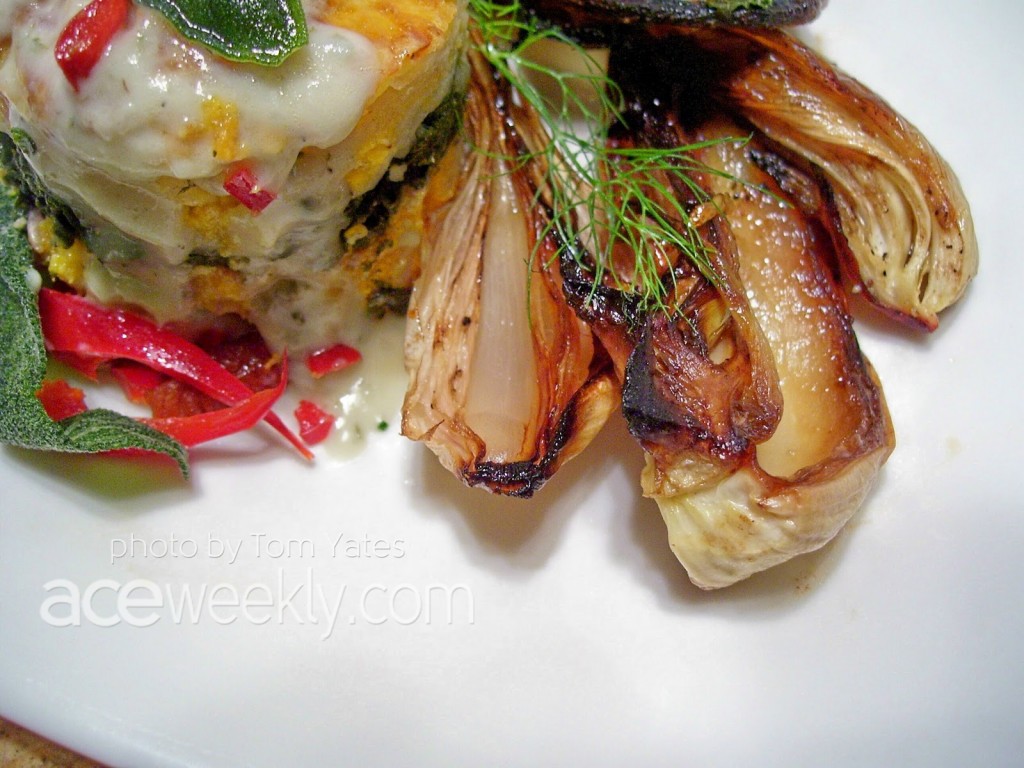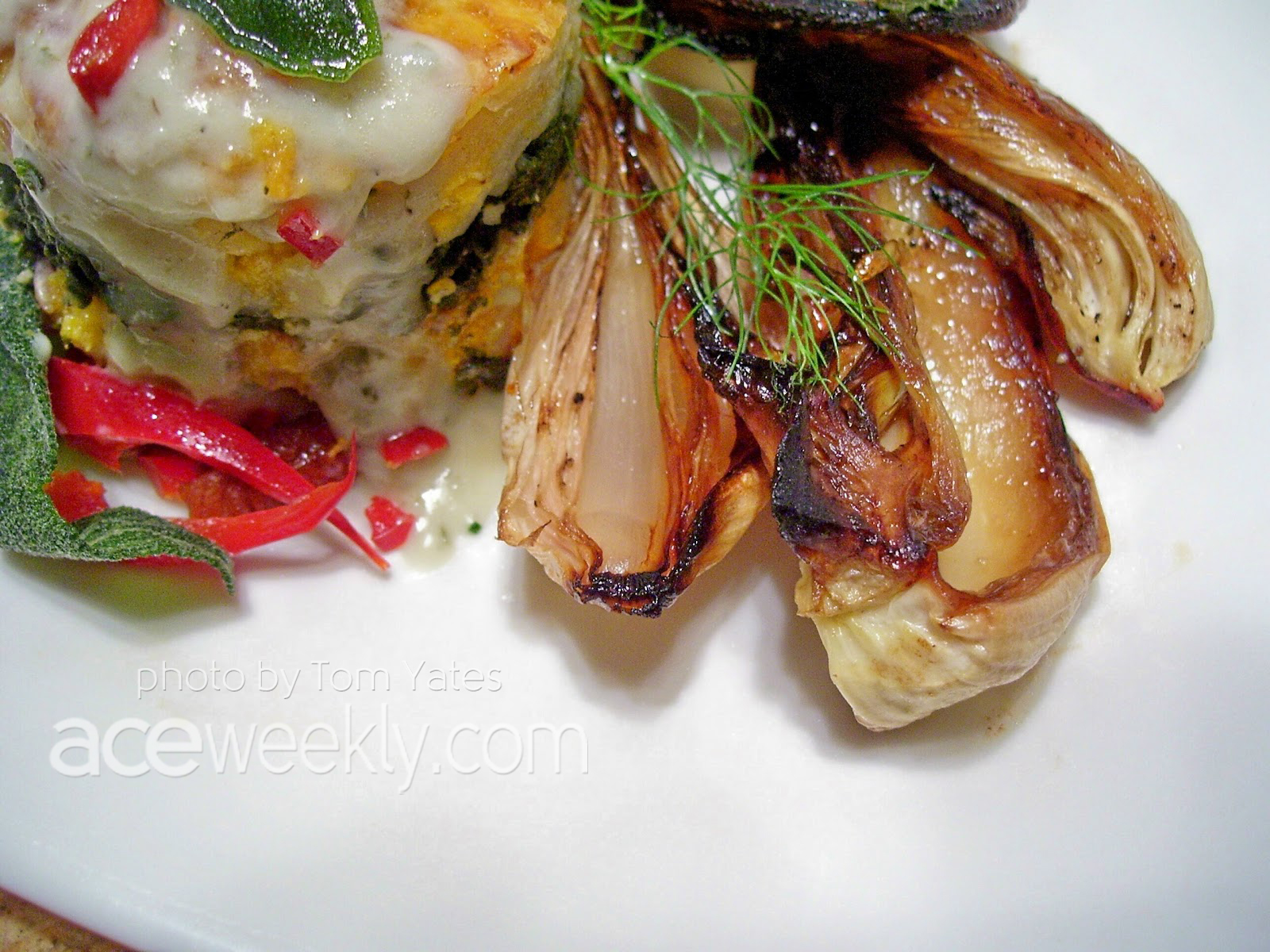Chef Tom’s Food and Cooking Column appears on page 13 of the Ace Weekly print edition. Text and Photos by Chef Tom.
When is World Pasta Day? Try this variation on October 25!
BY TOM YATES
I spent a quiet morning at the Tuesday/Thursday Lexington Farmers’ Market kicking stones along the gravel paths. While the smell of toasting crepe batter wafted through the cool crisp air, deep elongated autumnal shadows spilled across the almost empty lot subduing the colors of the pumpkins and mums. Peaceful foraging.
Casey County lima beans. Check.
Scott County turnips. Check.


Lately, I’ve been on a fresh pasta kick, cranking out huge batches once a week and using them for just about everything. Fresh pasta. Butternut squash. Butternut squash ravioli? Nope. While all the cool kids in town are turning out gorgeous variations of winter squash ravioli, I took a simpler route, using the same basic method for a less fussy butternut squash lasagna.
Store bought lasagna sheets would have worked beautifully, but I love making fresh pasta. I love the way it feels, smells, forms, bends, twists, turns, and tastes. Soft. Plump. Forgiving. Over the years, I’ve winged it when making fresh pasta. Flour. Eggs. Eggs. Flour. I’ve played with the proportions at whim. It never seemed to matter because the pasta always turned out great… until I accidentally stumbled upon the ideal combination while trying to tame a temperamental batch of fresh angel hair pasta. It was a revelation. In fact, a few months ago I was hired by an executive chef (for a very brief stint) based primarily on the fact that I could throw together a decent batch of finicky fresh angel hair pasta. It’s now my go-to pasta dough.
Butternut Squash Lasagna.
Mise en place.
I mixed 2 1/2 cups flour with 3 eggs and a pinch of salt. After pulling it together from the outside edges to form a straggly ball, I kneaded the dough for 10 minutes until it was soft and pliable before wrapping the dough in plastic wrap to rest and relax the glutens.
I carefully halved my Cleary Hill Farm butternut squash, scooped out the seeds, brushed the flesh with olive oil, and seasoned it liberally with salt and pepper. After placing the halves cut-side down on a sheet pan, I added 1/2 cup chicken stock (to help steam/roast the squash), and slid them into a 400 degree oven to roast for 40 minutes.
After cutting the pasta dough into fourths, I rolled each piece through my pasta machine, changing the setting after each pass, until I had four long pasta sheets. No cutting, stuffing, crimping, primping, or sealing. I simply sliced the sheets into 8 inch lengths. Done.
I pulled the roasted butternut squash from the oven to cool, brought a water-filled stock pot to a rapid boil, tossed a handful of salt into the rolling water, and cooked the lasagna sheets in batches until they were al dente (maybe a bit under al dente), about 7 minutes. After draining the pasta, I scooped the slippery sheets onto kitchen towels to drain and absorb any excess water.
When the squash was cool enough to handle, I scooped the orange mash into a large mixing bowl before adding 1 cup whole fat ricotta cheese, 1 cup grated pecorino romano cheese, 1 minced garlic clove, a pinch of nutmeg, salt, and pepper. I could have used a food processor to puree the mix, but I chose to whip it like mad it until melted into a lusty creamy butternut squash puree. Spoon, please.
Before assembling the lasagna, I simmered 2 cups of heavy cream with 4 fresh sage leaves until it thickened and set it aside. After quartering a large fennel bulb, splitting 3 green onion bulbs, and thinly slicing 2 lemons, I tossed everything with olive oil, salt, pepper, and pomegranate molasses before sliding them into a 350 degree oven to roast for 45 minutes.
I spooned a thin layer of the cheesy pureed butternut squash onto the bottom of a buttered deep casserole dish before building the lasagna with alternating layers of squash, grated pecorino romano, sage cream, and steamed fresh spinach. After four heaping layers, I topped the lasagna with a generous portion of grated pecorino and slid it into the oven to bake alongside the vegetables.


Instead of slicing the lasagna into wedges or squares, I used a ring mold to cut them into timbale-like round portions. After sliding them into pasta bowls, I drizzled the towers with sage cream, topped them with fried fresh sage leaves, and tumbled sweet red peppers to the side. I nestled the fennel quarters, onions, and lemons around the lasagna timbales, finishing with fresh fennel fronds.
Unlike more traditional hearty lasagnas, the butternut squash variation was soft, light, and delicate. The thin fresh pasta sheets melted into the layered fillings, leaving them with the texture of an airy mousseline. While the cream sauce gave a wink and a nod to sage without screaming holiday food, the pomegranate molasses-glazed fennel, onions, and lemons added a subtle sweet tart acidity that balanced the richness of the lasagna.










